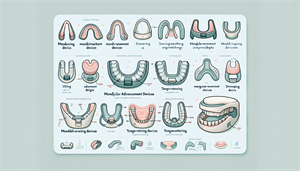When investing in a snoring mouthpiece, one of the first questions that come to mind is how long do snoring mouthpieces last?
The lifespan of these devices can vary considerably, typically ranging from six months to a few years, depending on factors like material quality, usage frequency, and maintenance practices.
In this article, we will delve into these aspects to help you understand what to expect and how to maximize the longevity of your snoring mouthpiece.
Key Takeaways
-
Snoring mouthpieces typically last between two months to three years, influenced by material quality, usage frequency, and maintenance practices.
-
Choosing between Mandibular Advancement Devices (MADs) and Tongue Retaining Devices (TRDs) impacts comfort and durability; custom-made mouthpieces generally offer better fit and longevity.
-
Regular cleaning, proper storage, and routine inspections are essential for extending the lifespan and effectiveness of snoring mouthpieces.
Lifespan of Snoring Mouthpieces
The expected lifespan of a snoring mouthpiece can vary significantly, typically ranging anywhere from two months to three years. Factors such as material quality, usage frequency, and maintenance practices all play crucial roles in determining how long these devices last. For instance, mouthpieces made from high-quality materials and properly maintained can last up to two years with regular use, whereas others may need replacement as soon as six months.
Understanding that the longevity of snoring mouthpieces goes beyond the initial investment is important. Selecting a durable device and maintaining it properly can reduce the need for frequent replacements, ensuring continuous effectiveness in addressing snoring. This approach helps save money and provides consistent treatment for snoring or sleep apnea.
Investing in a high-quality snoring mouthpiece is a commitment to better sleep health. Considering factors such as material quality, usage, and maintenance can maximize your device’s lifespan, leading to more restful nights.
Material Quality
The quality of materials used in snoring mouthpieces is a significant factor in their durability and effectiveness. Common materials include medical-grade thermoplastic and silicone, both known for their resilience and comfort. High-quality materials not only enhance the device’s effectiveness but also contribute to its longevity.
For example, softer materials like silicone can help reduce discomfort, which is crucial for user compliance and satisfaction. However, while silicone offers comfort, it may not be as durable as harder materials, potentially requiring more frequent replacements.
Balancing comfort and durability is crucial when selecting an anti snoring mouthpiece.
Usage Frequency
The frequency with which you use your snoring mouthpiece directly impacts its wear and tear. Regular use means the device will need to withstand nightly pressures, which can shorten its lifespan. Conversely, occasional use may extend its durability, but it’s important to use the mouthpiece consistently to effectively reduce snoring.
Maintenance Practices
Proper maintenance is crucial for the longevity of snoring mouthpieces. Following the care instructions provided by the manufacturer can help maintain the integrity and effectiveness of the device. Regular cleaning, for instance, prevents the buildup of bacteria and bad odors, which can degrade the materials over time.
Using a mouth lubricant can also be beneficial if the mouthpiece prevents your mouth from closing fully, ensuring a more comfortable fit and preventing unnecessary wear.
Good oral hygiene and proper maintenance can significantly extend your snoring mouthpiece’s lifespan, ensuring it remains effective in reducing snoring.
Types of Snoring Mouthpieces and Their Durability
Understanding the different types of snoring mouthpieces available can help you choose the best option for your needs. There are two primary types of devices. These are Mandibular Advancement Devices (MADs) and Tongue Retaining Devices (TRDs). Each type has distinct mechanisms and durability characteristics, which can influence their effectiveness and lifespan.
MADs are typically designed to move the lower jaw forward, thereby widening the airway and reducing snoring. In contrast, TRDs work by anchoring the tongue to prevent it from slipping back during sleep. Both types have their pros and cons in terms of comfort, durability, and effectiveness.
Additionally, snoring mouthpieces can be categorized into custom-made and boil-and-bite designs. Custom-made mouthpieces, created from dental impressions, offer a precise fit and greater durability. Boil-and-bite mouthpieces, while less expensive, provide a semi-custom fit that may not be as durable.
Mandibular Advancement Devices (MADs)
Mandibular Advancement Devices (MADs) are a popular choice for treating snoring and mild to moderate obstructive sleep apnea. These devices work by bringing the lower jaw forward, which helps keep the airway open during sleep. Typically made from medical-grade thermoplastic, a mandibular advancement device is designed for durability and effectiveness.
High-quality MADs, like the VitalSleep mouthpiece, feature patented adjustment systems that allow for personalized fit and enhanced breathing. Another example is the CareFusion ApneaRx, which allows for adjustments of the lower jaw position in 1-millimeter increments, facilitating a comfortable fit. These adjustable features not only improve comfort but also contribute to the device’s longevity by accommodating individual needs over time.
Furthermore, MADs can be customized using the boil-and-bite method, which involves softening the oral appliance in hot water and then molding it to the teeth for a better fit. This customization enhances the effectiveness of the device in reducing snoring and improving sleep quality.
Tongue Retaining Devices (TRDs)
Tongue Retaining Devices (TRDs) function by anchoring the tongue in place to prevent it from blocking the airway during sleep. These devices are often made from softer materials like silicone, which can impact their comfort and durability.
Some users prefer TRDs over MADs because they exert less pressure on the teeth and jawbone, making them a more comfortable option for some individuals. However, TRDs are generally less customizable than MADs, though they may come in different sizes to accommodate various users.
Custom-Made vs. Boil-and-Bite
Custom-made snoring mouthpieces are created from dental impressions, ensuring a precise fit tailored to the user’s mouth. These mouthpieces often provide better comfort and durability, but they can be significantly more expensive compared to boil-and-bite alternatives.
On the other hand, boil-and-bite mouthpieces are designed for users to create a semi-custom fit by softening the material in hot water before molding it to their teeth. While these mouthpieces are more affordable, their durability and fit may not match the level of custom-made options.
Signs It’s Time to Replace Your Snoring Mouthpiece
Knowing when to replace your snoring mouthpiece is vital for maintaining its effectiveness and your comfort. Key indicators are visible wear and tear, reduced effectiveness, and discomfort or fit issues. Regular dental evaluations can also help determine when a replacement is needed.
Visible signs of damage, such as cracks and chips on the device, can significantly impact its effectiveness and comfort. Additionally, a noticeable increase in snoring frequency or a resurgence of snoring symptoms despite using the device can suggest it is no longer working properly.
Discomfort or fit issues, like changes in jaw alignment or increased jaw soreness, are also common indicators that the mouthpiece needs replacement.
Visible Wear and Tear
Physical signs like cracks and chips on the snoring mouthpiece are clear indicators that it needs replacement. Ignoring such damage can lead to decreased effectiveness, making the device less capable of reducing snoring. Regularly inspecting your mouthpiece for visible wear and tear ensures it remains effective.
Regular wear and tear, such as surface abrasions or material degradation, can also impact the comfort and functionality of the mouthpiece. Addressing these issues promptly can prevent further damage and maintain the device’s performance.
Reduced Effectiveness
A noticeable increase in snoring symptoms despite using the mouthpiece can indicate that it is no longer effective. Monitoring your snoring patterns and being proactive about any changes can help you identify when the device needs replacement.
If you observe a resurgence in snoring or increased daytime sleepiness, it may be time to consult a healthcare professional for advice on whether a new mouthpiece is necessary.
Discomfort or Fit Issues
Discomfort or fit issues are common reasons for replacing a snoring mouthpiece. Over time, changes in jaw alignment can lead to discomfort when using a previously comfortable mouthpiece. An increase in jaw soreness or a decrease in the snug fit of the device can signal that it needs replacement.
A comfortable fit is crucial for the mouthpiece’s effectiveness in reducing snoring. If the device becomes uncomfortable or doesn’t fit well, it may fail to provide the necessary support to keep the airway open.
Extending the Life of Your Snoring Mouthpiece
Regular maintenance, proper cleaning, and appropriate storage are key to extending the life of your snoring mouthpiece. These steps help maximize the device’s lifespan and ensure it remains effective in reducing snoring.
Daily cleaning prevents bacteria buildup and odors, which can degrade the materials over time. Using a protective case for storage helps prevent physical damage and contamination. Regular inspections for wear and tear can identify minor issues before they worsen.
Proper Cleaning Techniques
Effective cleaning methods are crucial for maintaining the hygiene and longevity of snoring mouthpieces. Brush your mouthpiece daily and utilize cleaning gels, brushes, and dissolving tablets for a thorough clean. Avoid using aggressive cleaning products or hot water, as they can damage the mouthpiece material.
Using mild soap and cool water is recommended to keep your mouthpiece clean without compromising its integrity. Regular cleaning ensures that the device remains hygienic and effective, extending its lifespan.
Storage Tips
Proper storage practices are essential to maintaining the hygiene and longevity of your snoring mouthpiece. Allow the device to air dry before placing it in a protective case to prevent bacterial growth. Storing the mouthpiece in a case helps protect it from dust and physical damage when not in use.
A storage case helps maintain the mouthpiece’s shape and functionality, ensuring it remains effective in reducing snoring. Following these storage tips can prolong the life of your snoring mouthpiece.
Regular Inspections
Routine checks for wear and tear are essential to ensure your snoring mouthpiece remains effective and safe. Frequent inspections can help identify any developing issues, such as cracks or changes in fit, before they require replacement.
Cost-Effectiveness of Long-Lasting Snoring Mouthpieces
Investing in durable snoring mouthpieces can lead to significant savings compared to more costly surgical interventions or ongoing treatments. While the initial purchase price may be higher, the long-term benefits and reduced need for frequent replacements make them a cost-effective solution for treating snoring.
Comparing the costs of mouthpieces to other snoring treatments highlights their affordability and effectiveness. Anti-snoring mouthpieces and anti snoring devices are generally more affordable than surgical options, making them a practical choice for many individuals.
Initial Purchase Price vs. Longevity
Evaluating the cost-effectiveness of snoring mouthpieces involves considering the initial purchase price relative to their expected lifespan. For example, the CareFusion ApneaRx Sleep Apnea Mouthpiece costs around $199, while other high-quality options can be priced up to $361. These prices reflect materials and customization features that enhance durability and comfort.
Higher costs are often associated with better-quality materials and more customization options, which can lead to a longer-lasting device. Investing in a durable mouthpiece may have a higher upfront cost, but it can save money in the long run by reducing the need for frequent replacements.
Value for Money
The value for money of snoring mouthpieces is largely determined by their longevity and effectiveness. Mouthpieces that last longer provide better financial returns over time, as they diminish the overall expenses related to snoring treatments. For example, a high-quality, long-lasting mouthpiece can ultimately lower the costs associated with managing snoring.
Choosing a durable mouthpiece is a wise investment that contributes not only to financial savings but also to long-term well-being. By prioritizing quality and longevity, you can ensure effective snoring reduction and a better quality of sleep, making the initial purchase price worthwhile.
Summary
In summary, the lifespan of snoring mouthpieces varies based on material quality, usage frequency, and maintenance practices. Understanding the types of mouthpieces available, such as MADs and TRDs, and recognizing the signs of when to replace them are crucial for maintaining their effectiveness. Regular cleaning, proper storage, and routine inspections can significantly extend the life of your snoring mouthpiece.
Investing in a high-quality, durable mouthpiece may have a higher initial cost but offers long-term cost-effectiveness and improved sleep quality. By following the expert insights and tips provided in this guide, you can make informed decisions and enjoy peaceful, snore-free nights.
Frequently Asked Questions
How long do snoring mouthpieces typically last?
Snoring mouthpieces generally last between two months and three years, depending on the materials, care, and how often they are used. Regular maintenance can help maximize their lifespan.
What materials are commonly used in snoring mouthpieces?
Snoring mouthpieces are commonly made from medical-grade thermoplastic and silicone, offering both durability and comfort for users.
How can I extend the life of my snoring mouthpiece?
To extend the life of your snoring mouthpiece, regularly clean it with mild soap and cool water, store it in a protective case, and routinely inspect it for any signs of wear. Proper maintenance is key to ensuring its longevity and effectiveness.
What are the signs that my snoring mouthpiece needs replacement?
If you notice visible wear and tear, decreased effectiveness in reducing snoring, or experience discomfort, it's time to replace your mouthpiece. Regular replacements can ensure optimal performance and comfort.
Are custom-made mouthpieces worth the investment?
Custom-made mouthpieces are worth the investment due to their precise fit and increased durability, ultimately saving you money over time by reducing the need for replacements.




